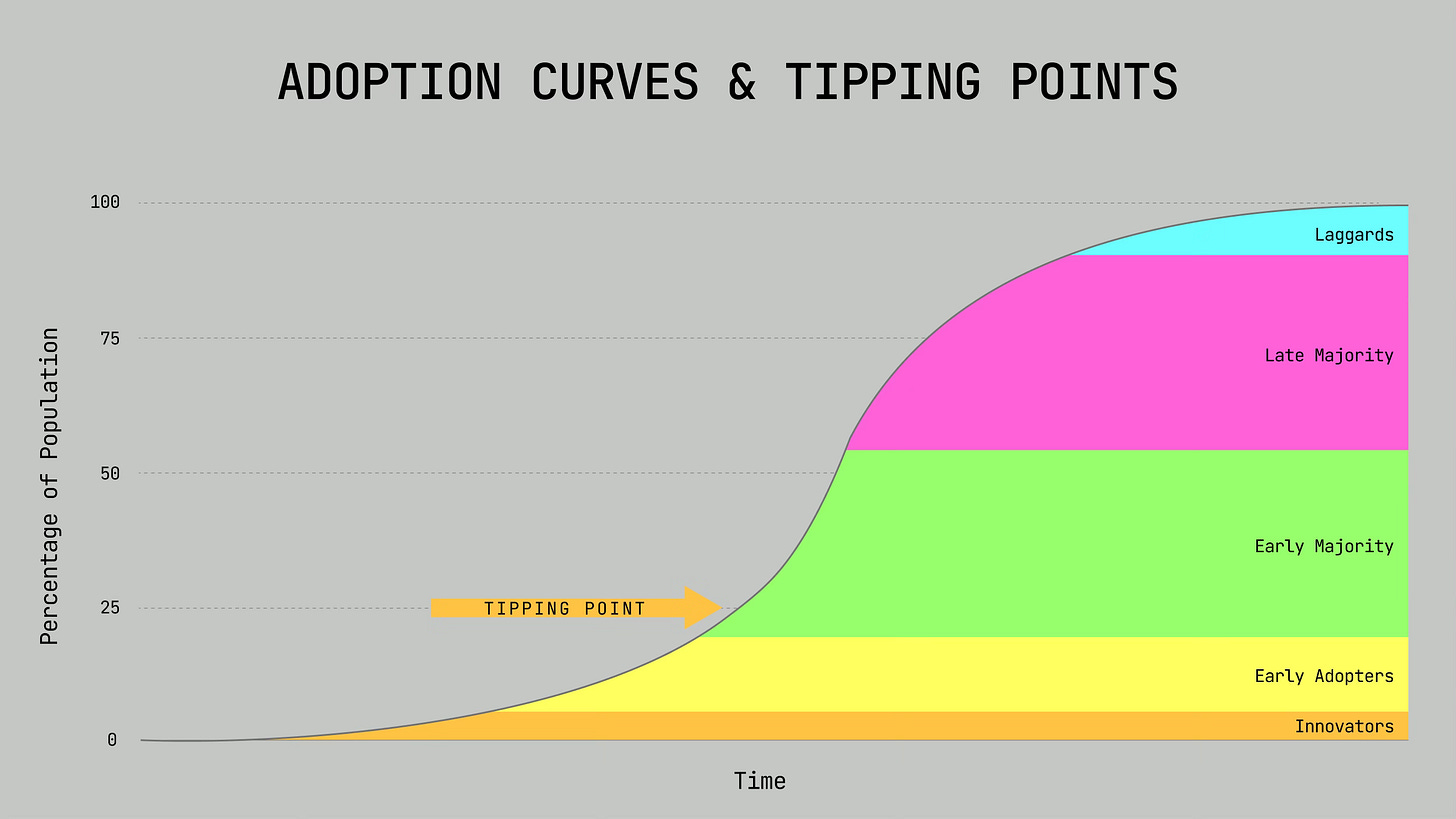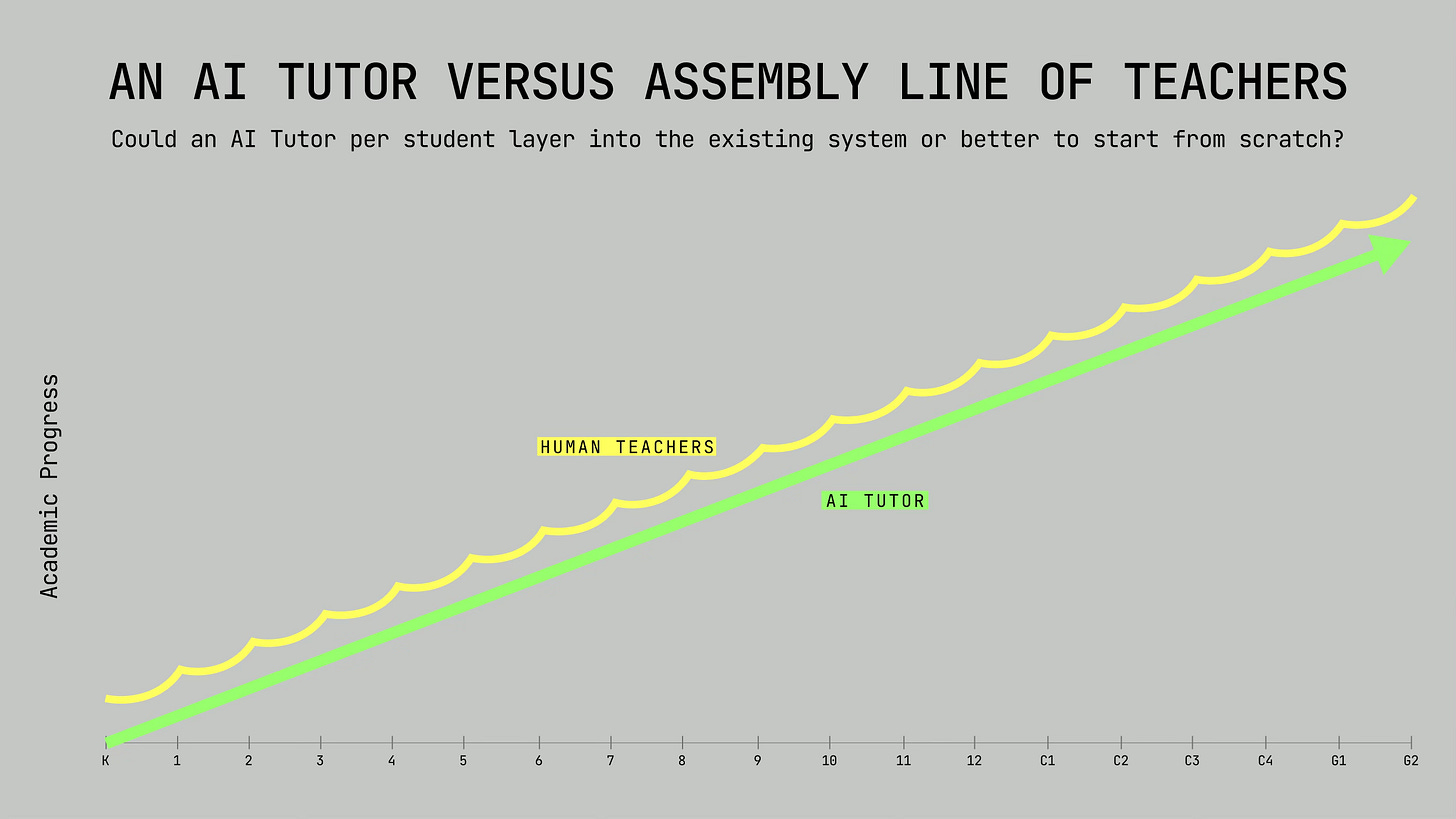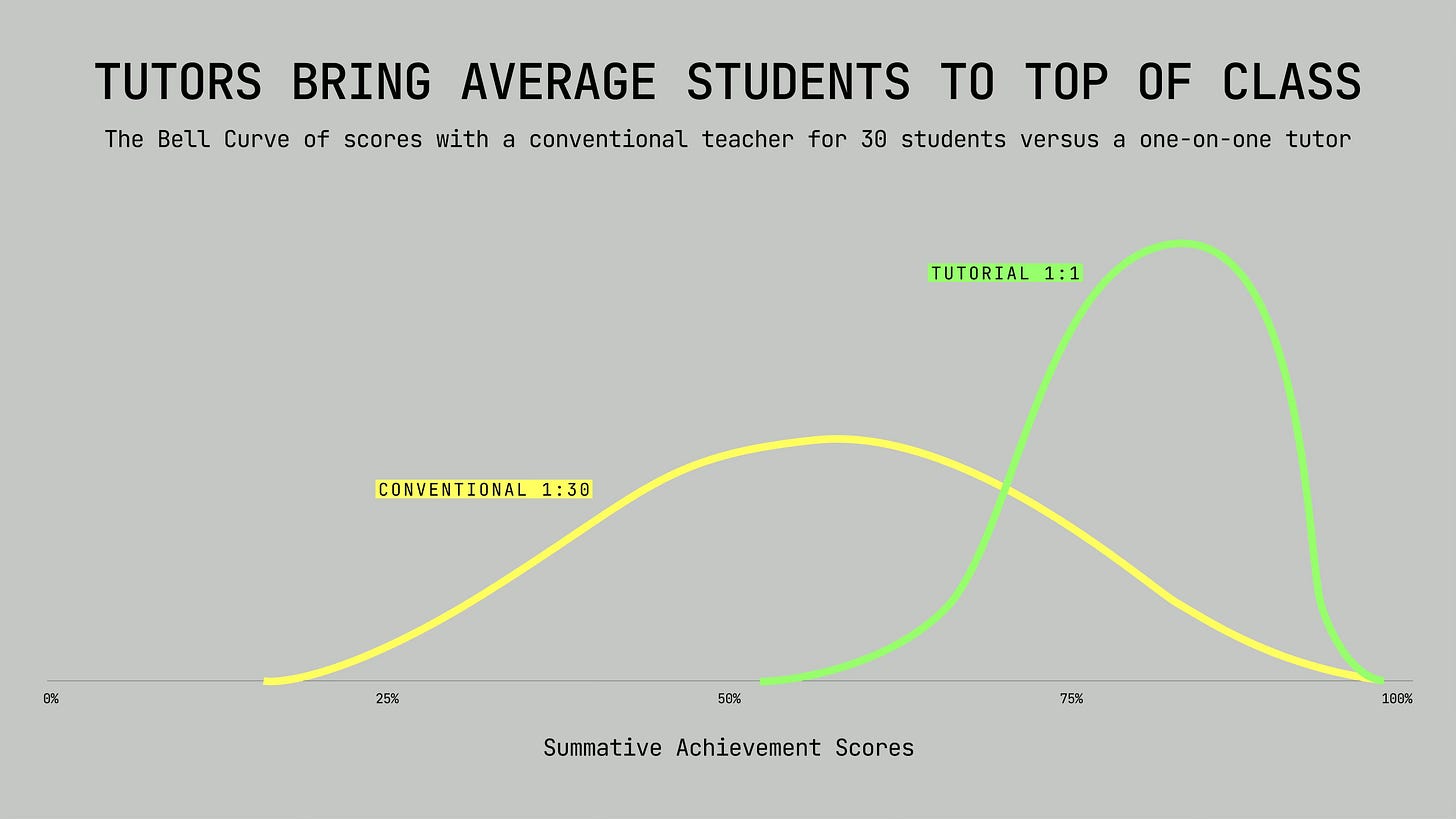The New Mantra: If You Could Start Fresh with AI, then What Would You Do?
The advance team of innovators In every industry and every field need to clean the whiteboards and think through how to rebuild their worlds based on the new foundation of intelligent machines
The more I have learned about artificial intelligence over the last several years, the more I have come to realize that we really should reinvent everything, in all directions, from scratch, starting now.
If we can’t jumpstart that kind of transformation for practical reasons, then we need to have advance teams of innovators in every industry and field start thinking through how they could rebuild their worlds from scratch by making the most of intelligent machines.
The rest of us could then do our very best to align with those roadmaps from what I call the “A Team” and practically rebuild those worlds off the new foundations of AI as rapidly as humanly possible.
This approach assumes, like I do, that artificial intelligence is a game-changing general-purpose technology with world-changing capabilities. It has now arrived, is rapidly improving, and will never go away.
This projects, as I do, that the 21st century is going to be fundamentally rebuilt around this transformative technology, and so we better get on with the inevitable process of reinventing our economy, society, and even civilization around machines that think.
This transition can start with a simple mantra that innovators in every industry and field — and really, any of us looking at the world today — should keep repeating: If you could start fresh with AI, then what would you do?
In business: What would an AI-first company look like if it could empower every human employee with an AI assistant that multiplies their productivity? What business tasks would it turn over to intelligent machines, and what new problems would it assign to employees?
In education: Imagine you could set aside the entire traditional system of K-12 schools. How could you devise a new system that starts by pairing each child with an AI tutor? How would you reimagine the role of human teachers in that learning process from ages 5 through 18?
In healthcare: If you could dismantle the current medical establishment, how would you start over? Pair each person with an AI doctor that monitors their health data in real-time and provides a daily consultation? Then you could make the most of your one annual visit to your human doctor.
In transportation: Start thinking about how a big city might work very differently in a world of AI. How much space devoted to parking could be reclaimed for housing if shared autonomous vehicles were the primary mode of transportation?
In government: After the Trump administration dismantles or cripples many of the federal bureaucracies, how could a foundation of AI allow us to fulfill the same governmental missions — ranging from regulating industries to caring for old people — more efficiently and at a lower cost?
My lesson number one from the tech world: Track the inevitable
One big lesson I have learned in my 30-plus years working in the tech world of Silicon Valley and the San Francisco Bay Area is to “track the inevitable.”
Once a new technology has passed the tipping point in adoption and proven its value to a critical mass of users, the scaling of that technology will inevitably proceed.
You won't be able to stop it, though you may be able to slow it down a bit. Ideally, as you head towards mass adoption, you’ll steer the nascent technology to maximize the benefits. This is true of any successful technology, but it is especially true of any general-purpose technology with wide applications, such as the internet.
Artificial intelligence has passed that tipping point, and the early adopters who understand it best are already rushing forward with new applications, giddily thinking about the possibilities to soon come.
We’re now entering the “track the inevitable” phase for mass adoption, and this time, the scaling is almost certainly going to happen much faster than it did with any previous general-purpose technology (if not any other technology, period).
That’s because, unlike those technologies, such as the internet or electricity, AI does not need time to build out a new physical infrastructure.
When I worked with the founders of WIRED magazine in the 1990s, we talked about how the internet would change the world. It ultimately did, but that vision of connecting everyone took 25 years to come to fruition. Stakeholders around the world had to lay fiber optic cables and erect high-bandwidth mobile phone towers within reach of all humans in every country. That took a lot of time, which gave societies a lot of time to adapt.
The same thing happened with the arrival of electricity — it took decades to string up electrical wires in every city and to all rural areas around the world, so societies back then had time to evolve how their economies worked with that new tool.
AI is arriving after we’ve already spent roughly 40 years building the entire infrastructure of the digital world, from the development of personal computers, to the build out of the wired internet, to the untethering of mobile, to the digitization of everything, and finally, to the connecting of it all in the cloud.
AI already has all the infrastructure it needs to start making a huge impact on the economy and society. Sure, tech companies can build more data centers, and string together faster chips into more powerful computers, but that’s just extending the capabilities of what we have already built.
My lesson number two from the tech world: Start from scratch
The second big thing I have learned in my decades in Silicon Valley is that the startups that start fresh and build from scratch on a new technology always win in the end.
Legacy tech companies — even highly successful ones that mastered the last era of innovation — do not lead the way forward into the new world of the next technology. At best, they buy pioneering startups and incorporate those companies’ new ways and new products as a way to keep up.
This has happened over and over again in the history of tech. IBM was the most successful technology company in the world in the 1960s and 1970s, but it was a startup called Apple that revolutionized the personal computer in the 1980s. Microsoft was the most successful technology company in the world when the internet arrived in the 1990s, but it was a startup called Google that revolutionized search.
Today, the company setting the pace for the development of AI is the startup OpenAI and not the most successful tech companies in the world, such as Google and Microsoft.
Why? Because tech startups always start from scratch with a new technology and build from the ground up for the next era. They ignore the past and think fresh about the new way forward.
Legacy tech companies are always entangled in the last tech era, the one they had pioneered and mastered. They find it very difficult to let go of the past and charge into the new.
The three takeaway lessons that we all should adopt now
The point of this essay is that America as a whole needs to learn from those two core lessons from the tech world as we now cross over into the AI Age.
One: AI has arrived, it’s here to stay, and we can now just track the inevitable as it scales up and begins to fundamentally change the economy and society. The debate is over. It’s now game on.
Two: Innovators in every industry and field need to act like startup founders. They must start from scratch and think through how whatever they’re doing now could be done very differently — and better — with AI.
And I’ll add a third point: We all gotta move fast. This tech train has left the station, and it’s a bullet train that is starting to pick up speed.
An example: K-12 education reimagined from the ground up with AI
Pick an industry or field, and you’ll almost certainly find that the leaders of its legacy companies and organizations are thinking about artificial intelligence as something to layer into their current systems somehow. It’s just a new tool that potentially improves what they are already doing.
They almost certainly are not thinking about how the arrival of artificial intelligence will completely change the game of what they do, forcing a fundamental shift toward new systems that bear little resemblance to the ones they have now.
So, let’s think about how AI could be used to reimagine a field that each of us understands well (because we’ve all been through it): elementary and high school education.
The mainstream conversation within that field has assumed the current system of how young people are educated will remain the same, and questions center on how AI might impact that system: Should we expose students to AI in the classroom? What are the rules in using AI for homework? How can teachers detect whether students used AI to write their papers?
The arrival of intelligent machines necessitates a fundamental rethink about how we might now educate young people, though. We need to be asking bigger questions:
What happens when we have the ability to give every child entering kindergarten an AI-based personal tutor? Unlike a human teacher, that virtual tutor could spend all of its time focused on that one student. The AI would learn about the child from every interaction in the classroom and at home, and it could build on that individualized knowledge over the years as the child progresses through developmental stages.
If AI truly is a game-changing general-purpose technology, then shouldn’t we be thinking about how the game of education could be fundamentally changed to work better for each student and all the overburdened teachers as well?
The Western K through 12 education system was devised in the 19th century in response to the Industrial Revolution and the scaling up of that era’s transformative general-purpose technology: the mechanical engine, which augmented human physical powers by orders of magnitude.
The education system, unsurprisingly, took on many of the characteristics of the economic system that educators were preparing young people to work within. The whole system is an assembly line of sorts, manufacturing the product — a young worker — in 13 distinct stages, or grades.
Each “product” has to pass quality control in the form of a battery of tests before it can move on to the next grade. In the end, each product graduates with a certification that it is prepared with everything it needs (skills in reading, writing, arithmetic, etc.) to plug into the economic system at the entry level. You get the point.
To make that educational system economically viable, one teacher is assigned to roughly 30 students at a time. That teacher may do their best to get all 30 students to understand the subject matter, but testing always shows that a small group at the far right of the bell curve will master everything, a similarly small group at the far left will fail miserably, and the vast majority of students will be in the middle of the curve, learning enough to move to the next stage of the assembly line. (See the image of the classic bell curve just above.)
We know from research over the last 50 years that any student, even one from the very bottom of a class, will eventually vault to the top if a human tutor is assigned to give him or her individualized instruction.
The most famous deep research on this was conducted by educational psychologist Benjamin Bloom in the 1980s. He showed that giving a child who fell in the bottom 50% of the distribution of test scores in a class one-on-one personal tutoring would improve his or her test scores by two standard deviations — that is the equivalent of moving them to the top 5% of the class.
Our current educational system can’t afford to hire enough teachers to provide individualized education to even those students who need it most, let alone all students. At best, wealthy people can hire tutors to give their children extra help outside the formal system — and they often do.
However, now we are seeing the arrival of AI, a transformative general-purpose technology that rivals the one that drove the Industrial Revolution, and it puts a personal tutor within reach for every student.
Doesn’t that change the game enough to force a fundamental rethink of how we educate all our children going forward?
Such a rework of the system does not mean that human teachers would all lose their jobs. Children at every stage of development will always need humans to teach them things that machines cannot teach. Kids need human role models, intuitive mentors, and emotional coaches.
This could be a win-win for today’s teachers, who are mostly overwhelmed by the need to not only teach the lesson plan, but also fill those other roles to large classes of students. They can think of the AIs as 30 teaching assistants, one for each kid in their class.
This AI-first rethink of our entire educational system was impossible before now. Not everyone will be able to wrap their heads around such a profound shift immediately, but the leaders and innovators of the field need to start now.
Track the inevitable. Something like this is going to happen over the course of the next 25 years, one way or the other, and it’s better that we get moving sooner rather than later.
Start from scratch. Attempts to retrofit AI into legacy systems will almost certainly fail in the end or, at the very least, be suboptimal. Think fresh and get it right from the start.
Whether you are in education or business or healthcare or transportation or government or whatever field, remember the mantra: If you could start fresh with AI, then what would you do?







I started reading by myself when I was 4. My brother never enjoyed reading the way I did. Public education was easy for me and a struggle for my brother. To this day my love of learning has centered around my ability to read. Just imagine a world where every child was tutored to read (and were taught to comprehend what they read) at a very early age. The human potential would be unprecedented.
Addressing just the application of AI to our educational system, it sounds great in theory, but it will cost money. Many families struggle to survive financially these days. How would this be implemented to all children equally? Government is cutting free lunches to hungry kids so I can’t imagine that they would be willing to make sure that even poorer families would get the same resources as those families with plenty of disposable income. I’m not arguing against it, just feel it is idealistic & not practical at this time. We need more compassion in our society.